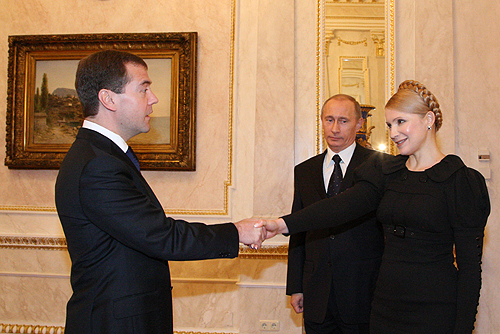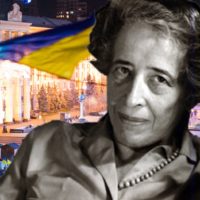The definition of energy security is vague and varying. It covers a wide range of threats and their countermeasures, which concern three main parts of the energy sector: the generation of energy itself or secondary energy carriers, their storage and transit to the end-consumer, as well as its consumption by the end-consumer. Each of these links of supply chains [see 1] has its unique features. The Ukrainian understanding of energy security underwent significant evolution after gaining independence in 1991. This article aims to find some sense and order in this congeries of events that influenced the progression of the perception of energy security in Ukraine through retrospective analysis. Additionally, the article serves as an example of the temporality of energy security and how versatile this term can be depending on the state and circumstances.
Speaking with Russia about Russian gas: energy security before 2014
Immediately after the victory of pro-Ukrainian forces in gaining independence from the collapsing Soviet Union, a critical economic issue emerged; restoring supply chains within Ukraine’s territory. The Soviet Union’s economic model, characterized by a „divide et impera“ approach, did not consolidate all stages of production within a single union republic. This fragmentation extended to various industries, including metallurgy and textiles. The energy supply landscape was no exception, with Ukraine heavily reliant on Russian gas for its energy needs. Consequently, Russia employed similar tactics and rhetoric during negotiations with Ukraine, often intertwining energy discussions with unrelated geopolitical matters. [2] For instance, they were discussing the issues of Crimea and the Black Fleet at the negotiations in Crimean Massandra altogether with the nuclear disarmament. The results were predictable: part of the Black Sea Fleet was given in exchange for the forgiveness of the $800 million gas debts. [3]
The Ukrainian government, therefore, sought diversification of the energy sources by exploring the options in the Middle East. However, as D’Anieri pointed out in the 1990s, the inability to pay in standard terms and on time and the lack of the necessary infrastructure undermined practical work in this direction. The existence of leverage on the Ukrainian side made the bargaining hurt not only Ukraine but both sides. [3] In addition, the new oligarchic clans; the Dnipro clan led by Pavel Lazarenko, Yulia Tymoshenko, and Igor Kolomoisky, and the Donetsk clan, in which Akhat Bragin, Yevgen Shcherban, Rinat Akhmetov and others played leading role, [4] lived the resale of energy resources from Russia to Ukraine, as well as privatization of the state-owned enterprises for nothing. They were well-presented in the parliament and put constant pressure on the president, Leonid Kravchuk or Leonid Kuchma. [5] Between 1995 and 1997, Pavlo Lazarenko, serving first as Vice Prime Minister for energy affairs and later as Prime Minister and then as one of the heads of the Dnipro clan, controlled the supply chains from Russia that were connected to Tymoshenko’s YEESU (Yedyni enerhetychni systemy Ukrainy – Unified energy systems of Ukraine) company. [6] Therefore, in the 1990s, energy security was concerned with preserving energy supply chains from Russia during the turbulent market reforms and privatization period. [7]
During this stabilization and energy sector development phase, Ukraine remained a pivotal transit player in the relationship between Russia and the European Union. This positioning exposed Kyiv to even greater Russia’s economic and political pressure. After the Orange Revolution, Russia seemed to lose all the pro-Russian advocates at the top political establishment in Kyiv. However, the renaissance of pro-Russian forces was yet to come. By 2004, under President Yushchenko’s leadership, Moscow sought to dissuade Kyiv from pursuing a pro-Western orientation, leveraging the expiring Massandra Accords. Recalcitrant Gazprom refused to prolong the agreement on the former terms and demanded a „European“ price for gas. The gas trade between RF and Ukraine was done at lower prices and often in barter – in exchange for some goods manufactured by the firms. This all was a big part of the scheme that the oligarchs used. The first gas war was resolved in January 2006 and ended with the creation of the transit organization RosUkrEnergo – an intermediary company owned by one of the oligarchs, Dmytro Firtash. [8]

The friction between Firtash and Tymoshenko, the Prime Minister in 2008, led to the second gas war. The history of this conflict is worth a different study, but briefly, Tymoshenko got all her wealth from a firm that imported gas from Russia and sold it to local enterprises. After the first gas war, the intermediary was established between Russia and Ukraine – RosUkrEnegro, owned by Firtash. The Prime Minister, Tymoshenko, wanted to change this status quo. Without informing then-President Yushchenko, Tymoshenko started to remove RosUkrEnergo from the supply chain, leading to an unfair agreement between Tymoshenko and the then-Prime Minister of Russia, Vladimir Putin. [8] These gas wars of 2005 and 2008 jeopardized state revenues from gas transit and impacted the energy bills of ordinary citizens. Internal disputes within the “orange team” (for example, conflict over the powers of the President, quarrels for the division of the seats in the Government, and the presidential ambitions of Tymoshenko) hindered effective reforms, including measures against Russia’s gas monopoly.
Energy security during this era involved safeguarding gas supplies from Russia and ensuring continued transit revenue, making it imperative for a government to control energy transit. As Kuchma stated in the interview, “The government wasted the nation’s energy after the Orange Revolution, [thanks to – author’s note] its inept personnel and economic policies in 2005-2006.” [9] After the election of Yanukovich as the President of Ukraine in 2010, the Donetsk clan held complete control over the energy sector. One of the significant signs of Russian influence over Yanukovich was the Kharkiv Agreement of 2010. According to them, Russia prolonged the rent of the Sevastopol military base in exchange for the lower gas prices. This agreement was the bomb that detonated four years later, in 2014, with the annexation of Crimea. Therefore, energy security in that period was tied to the preservation of gas supplies from Russia and the revenues from the transit. To put it in simple terms, it is an energy-secure government that controls the transit of energy.
Speaking of Russian gas with Europe: energy security during 2014-2022
The Revolution of Dignity of November 2013 – February 2014, occupation of the Crimea in March 2014 and the onset of Russia’s hybrid war in Ukraine’s Donbas region marked a significant turning point for Ukraine in general, and for energy security in particular. The first signs of this shift became visible after the signing of the Kharkiv agreements. Observers noted that the relations between Yanukovich and Putin after 2010 deteriorated significantly. They pursued different and incompatible aims: one wanted a discounted gas price, and another wanted Ukraine in a Eurasian Customs Union. [10] Yanukovich’s rejection of signing the EU association agreement at the Vilnius summit in November 2013 made it clear that Ukraine could no longer balance between the EU and Russia. The following Revolution of Dignity necessitated a response to Russian aggression. Russian proxies in Donbas obstructed access to high-calorie coal, prompting the introduction of the controversial „Rotterdam+“ scheme for coal supply from South Africa. [11] This scheme aimed to substitute the coal from the occupied territories with the coal from South Africa. The price of coal on the international exchange in the Dutch port of Rotterdam, where fuel is supplied from Africa and South America, was included in the tariff. This also included the cost of delivery to Ukraine, which is where the name „Rotterdam + delivery“ comes from – „Rotterdam+“ for short. [12]

The government also sought to reform the gas sector, as all imported gas up to 2014 came from Russia. [13] This reform was intended to diversify gas suppliers and to abandon Russian gas exports. Following the Revolution of Dignity, Ukrainian leaders voiced concerns about Russia’s weaponization of energy supplies and began advocating for a separation from Russia’s energy dominance. [14] Furthermore, they started articulating narratives of distancing the Ukrainian energy sector from Russia. The legal process of Naftogaz against Gazprom highlighted the enslaving nature of those agreements signed by the former governments. [15] The plaintiff, Ukraine, sought to challenge the 2009 gas contracts with Russia, which the plaintiff considered to be enslaving and unequal. Ukraine won the case. Also, Ukraine signed contracts with neighbouring Poland, Slovakia, and Hungary on the reverse supply of Russian gas. During the office of President Petro Poroshenko and the first years of President Volodymyr Zelensky’s office, energy security was the question of energy sector reformation to depart from Russia’s gas monopoly. Furthermore, the government during Zelensky presidency started talking about the green transition and diversification of energy mix in general, with introducing of green tax as an example. [see 16] Observers in 2020 recognized Ukraine’s potential to serve as a model for Central and Eastern Europe in this regard. [17] It became true only after the launch of Russia’s full-scale invasion of Ukraine.
New Challenges and Promises of Future: energy security after 2022
While CEE was concerned with the diversification and departure from the Russian gas needle, Ukraine met with another energy security dimension. During the Russian war against Ukraine, Russia used different strategies to break the Ukrainian resistance, including undermining energy delivery to the end-consumers via shelling the elements of critical energy infrastructure. The systematic destruction of power plants and high-voltage lines reformed the concept of energy security. The main question is how to secure the energy supply to end-consumers. While being theorized and conceptualized in many military doctrines [see 18] and even scientific articles [see 19], the Ukrainian government neglected this aspect of energy security for decades. No wonder energy infrastructure security is perhaps the most tightly intertwined with military security. It was a consequence of the state’s ignorance of Russia’s threat and the steps taken to demilitarize Ukraine before 2014. [20]
Looking ahead, a post-war Ukraine will require substantial resources for reconstruction, with estimates ranging from $200 billion to $1 trillion. [21] Prudent allocation of these funds will facilitate the restoration of damaged infrastructure and the development of a new energy sector focusing on green energy. President Zelensky has highlighted Ukraine’s potential to become a hub for green energy in Europe [22], given its abundant mineral resources, intellectual capital, and the opportunity for development in this sector. Furthermore, Ukraine could explore decentralization and digitization, as households are increasingly equipping themselves with generators and power banks for greater autonomy. A systematic approach in this direction could position Ukraine at the forefront of the global energy transition to carbon-neutral energy sources, an issue of paramount interest for many European states.
Herman Halushchenko, incumbent Minister of energy, is content that the war did not undermine the energy transition in Ukraine but rather accelerated it. [23] In addition, the current government and the President often refer to the potential of green hydrogen – another carbon-neutral energy source necessary for the transition. Thus, the EU has identified Ukraine as one of the priority partners of the European Hydrogen Strategy back in 2020, according to the Minister of Foreign Affairs Dmytro Kuleba. [24] All those quotes from the top political figures in the sphere of energy of Ukraine express the direction of the further development of Ukraine. The state does not only want to generate a sufficient amount of energy domestically but also is aimed at becoming a “gas hub of Europe” and sharing its experience of diversification and depriving from Russian gas with the EU. [25]

Those aspirations would improve the position of Ukraine in relation to the region and in general in the EU. Aside from the “breadbasket of Europe” label, Ukraine can also become the “energy hub of Europe,” improving the state’s economy and power. However, the big challenge is to identify the vector of development specifically. Either Ukraine is a “gas hub,” a prominent exporter and transit state for gas, which would be a conservative scenario, or Ukraine would champion the renewable energy sector and step on the track of European states and sustainability. Another big problem is the uncertainty. All those perspectives are highly dependent on the outcomes of Russia’s war against Ukraine. This “renewable energy hub” scenario is possible only if Ukraine wins. Otherwise, the influence of Russia would still be present in the country, therefore bringing many ramifications to it. The “gas hub” scenario is perhaps possible despite the war’s outcome. However, if that is the case, we cannot really talk about energy independence, and there are virtually no chances that Russia would proceed with exporting gas through Ukraine.
In conclusion, Ukraine’s energy security has evolved, addressing various issues from geopolitical considerations to energy infrastructure protection. The Ukrainian experience illustrates the versatility concealed within the term „energy security.“ Different analytical tools must be applied to each aspect for a comprehensive analysis of these topics, recognizing their interrelatedness within a broader continuum where past developments influence future considerations. One might argue that Ukraine was always concerned with being a transit state, and the modern change is just temporary, until the war is over. However, one is missing the leading narratives that prevail among politicians. This war led to reconceptualization of energy security of Ukraine, not only highlighting the issue of infrastructure, but also shifting the perception of Ukraine: before 2022, Ukraine was a transit state, but after the war, it can become a supplier of energy for Europe. This shift of supply chains is the reaction to the Russian deliberate aggression. This being told, most of the future plans heavily depend on the outcome of the Russia’s war against Ukraine, so there can be no certainty about which turn would the “energy security” concept take next.
Article reviewed by: Jan Míček, Dávid Dinič
Sources
[1] Balmaceda, M. M. (2021). Russian energy chains: The Remaking of Technopolitics from Siberia to Ukraine to the European Union. Columbia University Press.
[2] Tichý, L. (2020). Mezi Moskvou a Bruselem: ukrajinský energetický sektor na cestě do Evropy.
[3] D’Anieri, P. (1995). Interdependence and sovereignty in the Ukrainian‐Russian relationship. European Security, 4(4), 603–621. https://doi.org/10.1080/09662839508407242
[4] Tichý, L. (2020). Mezi Moskvou a Bruselem: ukrajinský energetický sektor na cestě do Evropy.
[5] Pirani, S. (2007). Ukraine’s gas sector.
[6] Ярмощук, Т. (2016, August 15). Незалежній Україні 25: чверть століття газової залежності? Радіо Свобода. https://www.radiosvoboda.org/a/27923519.html
[7] Чубик, А. (2016). Зовнішня енергетична політика України – ретроспективи та перспективи. Prism UA. http://prismua.org/external-energy-policy-of-ukraine-retrospective-and-perspectives/
[8] Balmaceda, M. (2009). Intermediaries and the Ukrainian Domestic Dimension of the Gas Conflict. Russian Analytical Digest, 53. https://ethz.ch/content/dam/ethz/special-interest/gess/cis/center-for-securities-studies/pdfs/RAD-53-9-12.pdf
[9] Штогрін, І. (2018, August 23). Леонід Кучма: «Красти у держави, яка воює – це мародерство». Радіо Свобода. https://www.radiosvoboda.org/a/29447940.html
[10] Åslund, A. (2013). Ukraine’s Choice: European Association Agreement or Eurasian Union? Peterson Institute for International Economics. https://www.piie.com/sites/default/files/publications/pb/pb13-22.pdf
[11] Справа “Роттердам+”: НАБУ і САП завершили розслідування другого епізоду. (2023, January 16). Економічна Правда. https://www.epravda.com.ua/news/2023/01/16/696015/
[12] Трегубова, Я. (2019, August 10). Формула «Роттердам +» і її наслідки: коротко про головне. Радіо Свобода. https://www.radiosvoboda.org/a/30103288.html
[13] Антоненко, А., Ніцович, Р., Павленко, О., & Такац, К. (2018). Реформа енергетичного сектору України: важливі незавершені завдання. Carnegie Europe. https://carnegieendowment.org/files/Ukraine_Energy_reform_UKR_Final.pdf
[14] Мацегора, К. (2014, June 4). Арсеній ЯЦЕНЮК: «Росія використовує енергетику як газову зброю». Урядовий Кур’єр. https://ukurier.gov.ua/uk/articles/arsenij-yacenyuk-rosiya-vikoristovuye-energetiku-y/
[15] Рішення Стокгольмського арбітражу: “Нафтогаз” виграв апеляцію по першій скарзі “Газпрому.” (2019, November 27). Економічна Правда. https://www.epravda.com.ua/news/2019/11/27/654187/
[16] Lb.Ua. (2022, March 10). Вітренко запропонував радикально збільшити податок на викиди вуглецю. LB.ua. https://lb.ua/economics/2021/02/23/478378_vitrenko_zaproponuvav_radikalno.html
[17] Dickinson, P. (2020). Ukraine’s gas market reforms can fuel change across Eastern Europe. Atlantic Council. https://www.atlanticcouncil.org/blogs/ukrainealert/ukraines-gas-market-reforms-can-fuel-change-across-eastern-europe/
[18] US Department of Homeland Security. (2019). A Guide to Critical Infrastructure Security and Resilience. https://www.cisa.gov/sites/default/files/publications/Guide-Critical-Infrastructure-Security-Resilience-110819-508v2.pdf
[19] Farrell, A., Zerriffi, H., & Dowlatabadi, H. (2004). ENERGY INFRASTRUCTURE AND SECURITY. Annual Review of Environment and Resources, 29(1), 421–469. https://doi.org/10.1146/annurev.energy.29.062403.102238
[20] Umland, A. (2023). A neutral and demilitarized Ukraine? Moscow’s demands of Kyiv in geostrategic perspective. http://hdl.handle.net/11159/604853
[21] Евенсен, Д., Совакул, Б., Далтон, Н., & Глебова, К. (2022). Енергетична безпека, зміна клімату та майбутня відбудова України. Boston University: Institute for Global Sustainability.
[22] Що більше доданої вартості виробляє Україна, то більше доданої безпеки отримують люди у світі – виступ Президента України на саміті філантропії Forbes 400 — Офіційне інтернет-представництво Президента України. (2023). Офіційне Інтернет-представництво Президента України. https://www.president.gov.ua/news/sho-bilshe-dodanoyi-vartosti-viroblyaye-ukrayina-bilshe-doda-77933
[23] Кабінет Міністрів України – Війна не зупиняє, а навпаки, прискорює «зелений» перехід України, – Герман Галущенко на Міністерському засіданні ініціативи Net Zero World. (2023). https://www.kmu.gov.ua/news/viina-ne-zupyniaie-a-navpaky-pryskoriuie-zelenyi-perekhid-ukrainy-herman-halushchenko-na-ministerskomu-zasidanni-initsiatyvy-net-zero-world
[24] Кабінет Міністрів України – Дмитро Кулеба: ЄС визначив Україну одним з пріоритетних партнерів Європейської водневої стратегії. (2020). https://www.kmu.gov.ua/news/dmitro-kuleba-yes-viznachiv-ukrayinu-odnim-z-prioritetnih-partneriv-yevropejskoyi-vodnevoyi-strategiyi
[25] Міністерство енергетики України. (2023, September 15). Герман Галущенко: Перетворення України на газовий хаб Європи – це реальність. https://www.kmu.gov.ua/news/herman-halushchenko-peretvorennia-ukrainy-na-hazovyi-khab-ievropy-tse-realnist





